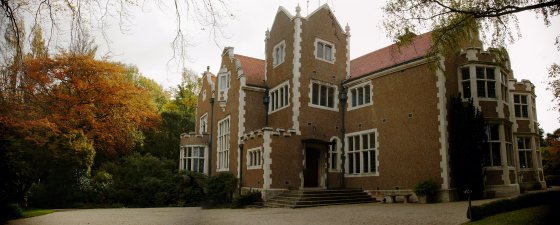A dash of the local

Arts and Crafts architects often used distinctive local materials to place their designs in a regional setting. There is an entry on Olveston in Hillary Grainger’s excellent book The Architecture of Sir Ernest George where she suggests that the Moeraki gravel pebbledash used on the outside walls was the architect’s idea. It is more likely that the actual selection of the wall finish was left to the local supervising architects Mason & Wales but the choice of material is still interesting.
Olveston’s walls are a combination of Oamaru stone and a cement render coat over the brickwork that takes its colour and texture from a careful application of small round pebbles ranging in colour from pale yellow through red and brown. From a distance the different colours blend into a strong tan. These stones were extracted from deep beds of the material at Moeraki on the North Otago coast , home of the spectacular spherical boulders that have been exposed by erosion. It is a geologically fascinating area and the subject of much study and curiosity over the years. Little, however, has been written on the gravels of Moeraki even though many know and recognise the material.
Most of us would think that sands and gravel are the result of the sea wearing the coast away but most of the material is in fact transported by rivers from sources many hundreds of kilometres distant. The roundness of the pebbles results from their tumbling journey from the Southern Alps. They built up in thick layers by old river beds and often contain different bands of colour and shape, depending on what rock was being cut away by river action upstream. The first newspaper reference to Moeraki gravel was in 1880 when purchasers were invited to inspect a load on the ship Mary Ellen. From that point on, the regular colour and pleasing shape of the gravel made it a popular material for garden paths and other decorative purposes. Many local houses were rendered using gravel from Moeraki, the best known being the two professorial houses at the University of Otago that got their coating in the 1930s.

